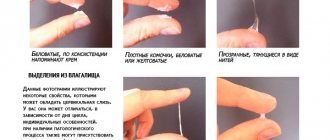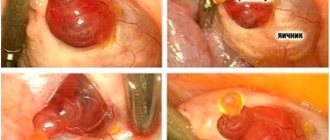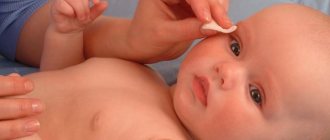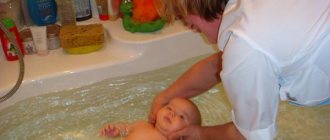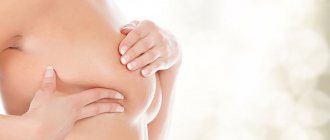What should be the temperature of a newborn?
The first days of life are the most difficult for the body. At this moment, all systems experience a slight state of shock, which is easily tolerated. Therefore, if you measure the temperature in the armpit of an infant, you can see 37.5 degrees Celsius on the thermometer. There is no need to worry or worry about this. At first, this is quite normal. The indicators will reach the standard limits of 36 degrees only in ten to twelve months. This is quite normal and even common.
In cases where the measurement takes place in the oral cavity, the thermometer reading will be at around 37.2. And if you use a rectal thermometer, you can generally see 38 degrees Celsius. In all cases, there is no need to worry or panic! While all systems of the body are being formed and configured for further work, they will be in this state. On his first birthday, the baby will be absolutely normal, like everyone around him.
The newborn baby is very weak. His system responsible for thermoregulation has not fully formed. That's why babies are so warm, but they can quickly become cold. The first sign that your child is cold will be hiccups or blue extremities. Don’t immediately wrap yourself up and take your temperature. It's also easy to overheat!
Measurement Features
Newborns in different conditions are characterized by certain temperature readings. A mercury thermometer should only be used in the armpit. It is allowed to take measurements in a sitting position after the baby grows up.
Parents should monitor the placement of the device. Don't forget about the dangers of mercury. The temperature of a child under one year old will show the correct value if measured over 8-10 minutes.
An electronic thermometer is considered completely safe. It's much easier to use. This will ensure that the correct result is obtained. It is simply irreplaceable in the first month of a child’s life. For ease of use, the device is equipped with a sound timer. The whole procedure will take no more than three minutes. Such a thermometer can be used for rectal and oral measurements. We should not forget that the result obtained in the armpit may differ by several degrees.
For the oral measurement method, the thermometer should be placed under the tongue. The procedure will take no more than one minute.
The normal temperature for a child under one year old will only be obtained if all preparations are carried out correctly. During the rectal measurement, the baby should lie on one side. At the same time, mommy presses his legs tightly to his stomach. It is also important to pre-lubricate the tip with Vaseline or baby cream . The result will be obtained correctly only if the thermometer is inserted into the rectum to a depth of at least two centimeters.
Some parents prefer to use a temperature indicator. This is a small strip with divisions that must be applied to the baby's forehead. It will take just a few seconds to get the result.
At 2 months, it is convenient to measure the temperature using a dummy thermometer. However, it is only suitable for those children who are already accustomed to this device.
Measuring a child's temperature
Normal temperature in a baby
Adaptation to the outside world is delayed by the usual activities necessary to care for the child. Namely: changing diapers and changing clothes. The body cools down very much in a matter of minutes. Therefore, children are susceptible to influenza and ARVI.
Normal temperatures will be between 36-38 degrees. But there are individual characteristics that need to be taken into account. Also, the measurement cannot be in one specific location. To understand the exact indicators, you will have to take measurements over two weeks and write everything down in a notebook. Indicators should be morning, lunch, evening. This is the only way to understand the real state of affairs in the body of a newborn.
How to measure a newborn's temperature
There are three types of thermometers for measuring human body temperature: mercury, electronic, mini-indicator. But, still, speaking of a small child, it is better to go with the electronic type, since it is more accurate than a mini indicator and, compared to a mercury indicator, safe. It is not advisable to measure the temperature immediately after the baby has eaten; it is better to do this between meals and at least an hour after physical activity. In this case, the baby should be in a calm state, not resist or scream. There are also several ways to determine temperature, which we will discuss below.
Rectally
This method involves placing a thermometer, pre-lubricated with glycerin or petroleum jelly, into the rectum. The baby can take two positions. In the first version, the baby is placed with his tummy on the lap of one of the parents, and in the second, with his back on a flat surface, raising his legs.
Next, the thermometer is deepened through the anal passage to 2 cm and held in this position for one to two minutes. After which the thermometer should be carefully removed and the result assessed.
Oral
This method means placing a thermometer in the oral cavity, preferably under the tongue. At the same time, it is important to hold the thermometer with your hand so that the baby does not accidentally damage or swallow it. And literally in a minute the result will be ready. It is very convenient to use an electronic thermometer for oral and rectal methods, since it independently beeps when the measurement result is ready.
Axillary
This method is the most popular among all listed. Usually the thermometer is placed in the left armpit, although this is unimportant, and pressed from above with your hand. It is important to ensure that the thermometer is not very cold, as this may cause dissatisfaction in the child. To do this, hold the thermometer in your hand for a few minutes so that it warms up. Then lower the mercury column of the thermometer to below 36 degrees. It is recommended to keep the thermometer in the armpit for 7 minutes, although 2 minutes will be enough.
Important! For axillary measurements, it is best to use a mercury thermometer, since an electronic one will show the result with a large error in this case.
To obtain average readings of a child’s temperature, it should be measured twice a day - in the morning and in the evening (at 17:00). If the child is sick, it is measured at least every 3 hours.
Should I worry if my baby has a temperature of 37?
If the baby has a temperature of 37 ºС, then there is no need to worry. This is a completely normal indicator, which is average for such a situation. It's definitely not worth giving medications. Especially if the age is several months! But, if it is discovered that this is above average, and this temperature lasts for several days, it needs to be brought down. Additional symptoms will be those that appear during a cold in all people.
Children's bodies are more susceptible to the influence of the outside world. Therefore, it is especially important to monitor the child’s condition!
Hyperthermia in children
Body temperature can be:
- elevated (37.1ºС – 38.0ºС);
- high (38.0ºС – 38.5ºС);
- fever (above 38.5ºС).
Increased performance
An increase in body temperature in children under 1 year of age can be caused by:
- overheating;
- taking certain medications;
- inflammatory processes.
A slight increase in temperature can be observed in an absolutely healthy child in the morning, after eating. It occurs due to the peculiarities of energy metabolism in young children.
If your baby has a fever, you first need to make sure that he is dressed for the weather. The cause of hyperthermia may be too warm clothing or a stuffy room. In this case, the child must be undressed (the optimal air temperature for the baby is no more than 25ºС)
If the baby is dressed for the weather and the temperature persists for some time, it is better to consult a doctor. It may be due to various kinds of diseases, such as: heat imbalance, infectious diseases, inflammation.
Elevated body temperature does not need to be brought down; the fact is that its slight increase is a mechanism of protection against infection.
It is important to know! In some cases, an increase in temperature up to 37.5ºC may occur due to congenital diseases or heat exchange disorders.
Heat
Temperatures above 38ºC in infants occur due to various diseases, but the most common cause of its occurrence is teething. Only a pediatrician can determine the exact cause.
High temperature negatively affects the child’s body, so it must be reduced by using paracetamol-based drugs.
For infants it is better to use:
- candles;
- syrup;
- suspension.
To lower the temperature, the baby must be undressed. Give plenty of fluids, as at high temperatures dehydration occurs and it is necessary to replenish fluid reserves. In addition, if you constantly give your child something to drink, this will help lower the temperature. If the fever does not subside, the baby needs to be given medicine (syrups and suspensions are used orally, suppositories - rectally). The exact dosage is prescribed by the doctor .
Heat
If a child has a body temperature above 38.5ºC, it should be brought down as soon as possible and an ambulance should be called. In the heat, pathological changes in organs and systems are possible. Temperatures above 39.9ºC can be fatal.
If there are no medications at hand, the fever can be reduced by rubbing with cool water.
Rubbing the baby with water and vinegar or vodka is strictly prohibited. The thing is that the toxins of these substances enter the baby’s body through the pores on the skin and lead to poisoning.
When teething, it is recommended to give antipyretic drugs with an anesthetic component:
- "Nurofen";
- "Ibuprofen";
- "Cefikon D" candles;
- "Efferalgan" candles.
If you have hyperthermia, you must take your temperature after taking medications. It is advisable to take measurements every half hour so as not to miss a significant increase (over 40ºC).
It is important to know! Hyperthermia is not only a symptom of the disease, but also harms the child’s health. As the temperature rises, the heartbeat and breathing increase, which can lead to irreversible changes in the functioning of organs. In extreme heat (over 40ºC), the child may die, and the cause will not be illness, but hyperthermia.
What temperature is considered high in a baby?
The answer here is quite simple. Anything that is not the norm. That is, special measurements are carried out for this purpose. Then, using the records, it will be easier to monitor the general condition. If the temperature has dropped and risen within one degree, then you need to pay attention to this. Especially in cases where such indicators last more than one day.
There are several reasons that influence the rise in temperature. Basically, these are diseases of a very different nature. The most common will be influenza and ARVI. But different options are possible. In any case, consultation with a doctor is necessary only in moments when the indicators rapidly deteriorate or last for several days!
Reasons for fever in a 1 month old baby
What should a baby's temperature be at 2 months?
Most often, parents are frightened by asymptomatic fever. If there are no acute viral infections, then this condition of the infant may be caused by the following reasons:
- In hot weather, children easily overheat due to their low body weight, low activity of sweat glands, and limited heat transfer by warm clothing.
Overly wrapping a baby can cause a fever
- A stuffy room causes the baby to overheat, if, in addition, a caring mother wraps him up tightly, despite the heat in the room.
- Paradoxically, cold air can also cause an increase in body temperature. Although heat generation in newborns increases in the cold, it is exceeded by a high level of heat transfer. Thermoregulation mechanisms are unable to cope with prolonged exposure to heat and cold. This causes the tiny child's temperature to increase (exonic hypertemia) or significantly decrease (exonic hypotemia).
Signs of elevated body temperature in infants
Young children may react differently to increased body temperature. Their reaction will depend primarily on the reason that caused the increase in temperature. Signs of a high temperature may include:
- lethargy or excitement;
- thirst;
- dry mucous membranes (lips, tongue);
- increased heart rate; increased breathing;
- bright blush on the face, “flaming” cheeks (and in some cases, on the contrary, pallor);
- red, inflamed or very shiny eyes; chills;
- sweating
Increased heart rate and respiration are considered significant signs of increased temperature, for this reason it is necessary to be able to assess the characteristics of pulse and respiration rates.
The normal heart rate of children is 100-130 beats per minute during sleep and 140-160 during wakefulness. When crying, the pulse is 160-200 beats per minute. As for the breathing rate, newborns typically take 40 to 60 breaths per minute. It should be understood that certain children do not react at all to an increase in temperature.
We recommend: Bradycardia in children
Factors to consider when measuring the indicator
It is better to measure the temperature of newborns comprehensively and consistently, recording the obtained indicators in a separate notebook and tracking the dynamics. In this case, it is necessary to take into account factors that can significantly influence the result:
- Features of circadian rhythms. The vast majority of children have a lower temperature at night and in the morning than in the afternoon and evening. By the evening, the indicator may generally increase by half a degree compared to the morning.
- Child's age. On the first day of a baby's life, he experiences transient hyperthermia. Temperatures during this period can quickly jump from 36ºC to 37ºC and even 38ºC. When the baby is a couple of weeks or a month old, the long-awaited stability will come. It is worth considering that in the first three months of a baby’s life, he is most susceptible to changes in body temperature in response to external factors.
- Individual characteristics of metabolic processes. The well-known figure of 36.6ºС is conditional from a medical point of view. Many children and even adults live with a body temperature of at least 37ºC, and they are absolutely healthy.
- Current condition of the baby. The temperature of a newborn can fluctuate within noticeable limits depending on whether he is excited or calm. In the first case, it is better to postpone the measurement altogether.
- The period after vaccination. It can also cause temperature fluctuations within insignificant or noticeable limits (up to 37.8 - 38.3ºС). Parents are advised to monitor this parameter for several days after administration of the drug, reporting to the doctor if there are sudden changes or too significant deviations.
In premature babies, the temperature returns to normal no earlier than 3-4 months. The adaptation process will noticeably speed up if you regularly give your child baths and air baths.
Is it necessary to lower the temperature?
An increase in temperature due to any illness will require consultation with a doctor. However, before the doctor arrives, if the child has a fever, one of the non-medicinal methods of reducing the temperature should be used. As a rule, a temperature that does not rise above 38° C does not need to be reduced. The most significant temperature, especially when accompanied by other signs or disturbances in the child’s behavior, will usually require reduction.
A temperature greater than 38.5°C in absolutely all children under one year of age and above 38°C in a child with a history of seizures or other lesions of the central nervous system will undoubtedly require a reduction. But the final verdict on the issue of reducing temperature always remains with the doctor.
What temperature should be normal?
A newborn finds himself in an environment whose temperature differs sharply from his usual temperature. A full-term healthy baby at birth has a body temperature of 37.6-38.2° due to fluid loss and birth stress, but this quickly passes. In the coming hours it drops by 1.5-2 notches. In addition, the temperature in newborns in the first month ranges from 36.3 to 37°.
The mother should not worry about such fluctuations; on the contrary, maintaining the good condition of the child is carried out taking into account precisely this feature.
For your information. Screaming, crying, anxiety, excessive activity in the evening are the reasons that increase body temperature to 38 degrees and above. If the temperature does not drop in a calm state, it is necessary to look for other causes and eliminate them.
How and how to reduce the temperature of a baby?
To reduce the temperature in young children, wiping with a sponge soaked in warm water is effective. When rubbing, children's skin cools due to the evaporation of moisture from its surface. It is better to start wiping from the face, neck, then you need to switch to the arms, legs and torso. It is impossible to wipe with alcohol or cold water - this causes a rapid reduction in skin temperature and vascular spasm, which leads to a reduction in heat transfer and, accordingly, an increase in temperature. If the increase in temperature is accompanied by chills, children can be covered warmer.
Drinking plenty of fluids can also help reduce fever. Obviously, you won’t be able to convince your baby to drink more, for this reason you need to more often persistently offer him his favorite herbal tea, juice, etc. When sweating, you should change your underwear (underwear and bedding) more.
To reduce high fever in a child up to one year old, medications are used, the functioning element of which is paracetamol. These are drugs such as “Panadol”, “Tylenol”, “Efferalgan”, etc. (if you are buying an antipyretic drug, focus on the packaging: next to the trade name of the substance, the name of the active element should be written in smaller, often Latin, letters - that is, the element that exhibits a healing effect). Suppositories, syrups, drops, and solutions are considered more suitable for children.
Recently, substances of a different category that do not include paracetamol have also found widespread use - viburkol (suppositories), hexapnevmin (suppositories, solution). It is not recommended to use aspirin as an antipyretic; it often causes complications in young children.
You should not mix medications into formula or drinks. And the most important thing that parents should know about medicinal methods of fighting fever, especially in a child under 3 months of age: only a doctor should prescribe medications and their doses.
Indicator norms
Normal temperature in a baby is an ambiguous concept. Its value directly depends on the measurement method:
- In the armpit area - from 36 to 37.3.
- With the oral method of measurement - from 36.6 to 37.2.
- Rectal version – from 36.9 to 38.
In newborns, the process of developing thermoregulation is still ongoing. Their body gives off too much heat, so they often get cold. In this case, the baby begins to hiccup. Parents may also notice bluish discoloration of the arms and legs.
Newborn
Important! Breasts can easily become cold or overheated, both of which are dangerous and can cause harm.
Additionally, it should be noted that the swaddling process will delay the formation of natural thermoregulation. The child cannot adapt to external conditions. In the future, the risk of colds increases. That is why the baby only needs regular care.
The normal temperature for a child up to one year old varies from 36 to 38 degrees. In this case, the measurement principle plays an important role. However, other physiological characteristics should also be taken into account. To determine the indicator, it is necessary to take measurements twice a day. Thanks to this, it will be possible to determine the average stable body temperature.
When should you call a doctor?
A doctor should be called immediately if an infant's temperature rises above 38 ºС. The younger the baby, the more dangerous a rapid and significant increase in temperature is for him. A long and constant use of antipyretic drugs can create the illusion of well-being and hide the formation of complications, which will lead to a delayed prescription of treatment. Even after successfully coping with a fever, you cannot calm down - you should definitely show your child to a doctor.
When inviting a doctor, you should not think that the call may be a manifestation of unreasonable anxiety, and the child’s illness is in no way so serious as to be a reason for concern. It is necessary to keep in mind that the child’s health is much more significant than those emotions that sometimes appear in very shy parents or in overworked medical workers, since a delay in starting treatment can result in complications in the child’s health in the future.
How to maintain the norm
There are simple methods for creating comfort:
- Room temperature +20-24 C.
- A child under one year of age should be dressed in a smaller layer in summer and in a larger layer in winter than an adult is dressed.
- To maintain normal temperature at night, newborns are covered with a blanket made of natural materials (cotton, wool). This will promote proper thermoregulation and heat retention.
- For walks, dress your baby according to the weather and season. You must have a hat on your head (the thickness depends on weather conditions).
- Up to a year, it is advisable to hang a wall thermometer to control the temperature.
- To check, place your palm on the back of the baby's head. Warm - everything is in order, cool - you will have to reconsider the amount of clothing on the baby.
- In the process of hypothermia, the body color changes from normal to bluish, and the baby may begin to hiccup. In this case, the temperature of the baby is not measured. It is necessary to provide comfortable warmth for a small body.
Overheating is dangerous and is more difficult for children of any age. Particular attention is paid to care in the summer heat, when elevated temperatures are fraught with dehydration and other dangerous ailments. To prevent an unpleasant moment, parents should adhere to the following tips:
- Drink plenty of fluids during hot periods, and frequently breastfeed during breastfeeding.
- Minimum clothing in summer (light shirt and cotton sheet).
- The route for a street walk should be laid in the shade among trees, and not in open areas under scorching rays.
- Panama hat, hat, scarf are required.
- It is forbidden to leave a baby under one year old in a stroller in the summer for a daytime nap without supervision. The sun will heat up both the stroller and the baby, causing harm to a weak body.
- You should not lock your child in the car in the parking lot - plans to step away for a minute will end in failure.
Body temperature values are influenced by many factors, parents are able to control them. This will provide maximum care and raise the baby healthy and hardened.
We present to your attention a video in which a pediatrician tells a young mother about the normal body temperature of a newborn baby.
Rules for caring for a child with a high temperature
- There must be fresh air in the room. It is necessary to periodically ventilate the room (while taking the child out). It is better to maintain the air temperature around 20 degrees. It is better to turn off electric heaters, if any.
- If you have a humidifier, it is better to turn it on.
- It is not recommended to place a child with fever on polyethylene (under a sheet, on a mattress). Polyethylene will additionally “add” heat.
- If it is impossible to cool the air in the room, then it is better to remove the child’s diaper.
- There is no need to cover and “bundle” the child.
- Don't worry if your child eats almost nothing. This is fine.
- Be sure to ensure that your child drinks a lot (but in small portions so as not to induce vomiting). You need to drink every five minutes, you can give water from a syringe without a needle, just a few sips.
- If the child is sleeping, do not wake him (unless there are dangerous symptoms: wheezing, convulsions, acetone in the urine).
Parents often become very nervous when a child, especially a young child, has a fever. Remember that in young children both deterioration and improvement occur very quickly.
At any time of the day or night, it is necessary to maintain the temperature and humidity conditions in the baby’s room, so install a high-quality humidifier and air ionizer for the baby.
When shopping at Mom's store, we guarantee pleasant and fast service .
Health to you and your baby!
What is body temperature
Body temperature is an indicator of whether thermoregulation is carried out normally in the body, how much heat is produced, and how much is given off to the outside. The mechanism of stable thermoregulation does not begin to work immediately; the baby is born with a “untuned system.” Therefore, children under three months cannot maintain a constant body temperature themselves, and very sensitively “respond” to fluctuations in ambient temperature. That is why it is much faster and easier for a child to become overheated or overcooled than an adult.
The imperfection of the thermoregulation system also explains the frequent rise in temperature in the first week after birth. In this way, the baby adapts to existence outside the mother's belly. In this case, an increase in temperature to 38-39 degrees may be observed. This phenomenon is called transient hyperthermia.
By the age of 3 months, the child’s thermoregulation process improves, and the baby has his own “schedule” of temperature changes during the day. You need to understand that the temperature of different parts of the body varies, and take this fact into account when measuring.



